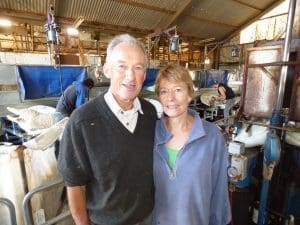
Phil and Karen O’Toole.
HAWKESDALE prime lamb producer Phil O’Toole thinks sheep shearing on raised platforms seems to be the way to go for shearer safety and sheep welfare.
“We will be doing it again next year.
“I don’t think it is a fully evolved system yet and the only way it will become fully evolved is trying it gradually it will probably be more efficient,” he said.
“I’m still in the growing phase with it and I’m not out there to sell it as yet; I think it needs fine-tuning.”
NSW wool grower Grant Burbidge’s team shore just over 3000 sheep, lambs and rams for Phil and Karen O’Toole after their conventional shearers demanded his composite ewes with saleable lambs be kept off feed and water for up to 48 hours before shearing.
Phil said the two main advantages of the platform system were health and safety for the shearers and a better welfare outcome for sheep.
“We can shear sheep within curfews, we can shear big sheep within curfews.
“If we are serious about being transparent in the sheep industry and standing proud when urban people look at us then we’ve got to be within sheep animal welfare recommendations,” he said.
Click here to get the latest Sheep Central story links sent to your email inbox.
Phil estimated his composite ewes weighed from 75-100kg, with one of the lighter mobs averaging 78kg within a range 63-95kg. His rams weighed up to 120-130kg and were shorn without sedative.
Without having an exact figure on the cost of platform shearing, he was happy with the result.
“We certainly saved on shed staff.
“The skirting and treatment of the wool by (experienced shearers) Ryan Cotter and Abe Gwada was perfect,” he said.
“In fact, it seems that they can be more prudent with the pieces than what a lot of the skirters are; they weren’t pulling as much white wool as some skirters do.”
He believed clip preparation in a platform shearing system can be “as good” as in a conventional wool shed system with roustabouts, wool rollers and a classer.
Light shearers, heavier sheep

Platform shearer Abe Gwada.
All of the shearers at Phil and Karen O’Toole’s shed weighed less than the 80-100kg-plus composite ewes and rams they were shearing, but were still happy in the job.
Abe Gwada, 23, originally from Sudan and now an Australian citizen, worked as a gardener and filled shelves at a supermarket before starting to shear for the Burbidges two years ago. He shore around 10 sheep on his first day and now shears around 100-130 Merinos a day and about 150 crossbreds. With his weight at around 70kg, there was “no way” he would be shearing if he had to drag sheep across board.
“We are nowhere near our best yet.”
Abe shore up to 150 of the O’Toole composite ewes in a day and averaged around 130 for the shed.

Platform shearer Ryan Cotter.
Ryan Cotter, 22, and weighing 76 kg, said he would have been working at a recycling plant in Melbourne if he didn’t take up shearing in the platform system two years ago.
“It’s still hard labour, but I don’t have to bike 17 kilometres to get to work.”
He said he would give conventional shearing a go, but didn’t believe he would last as long as he has with the platform system. He shears between 80-110 sheep a day.
“Holding the sheep when you do that finishing blow is the key thing.”
He believed showing conventional shearers that good tallies were possible with the cradles was the key to getting their support.

Learner shearer Conor Madden at Hawkesdale this month.
Prawn boat deckhand Conor Madden said he did 32 composite ewes on his first day shearing, lifting his tally to 102 within eight days, but losing a few kilograms of his 78kg weight along the way.
“It’s a bit different to what I’ve been used to, but I’ve been enjoying myself.
“It’s the hardest job I’ve ever done.”
Grant said that one person he recently did a shearing job for, said that apart from all the benefits in ease of use and wool preparation, he thought the biggest advantage with the platform shearing was the change in culture, where everyone in the shed is directly working on clip preparation.
“We certainly have spent a lot of time in the last 18 months training people in the shearing shed and the most satisfying part has been the pleasant and collaborative work place environment.
“So for all the efficiency gains and the positive culture we will certainly continue to shear sheep this way,” Grant said.

HAVE YOUR SAY